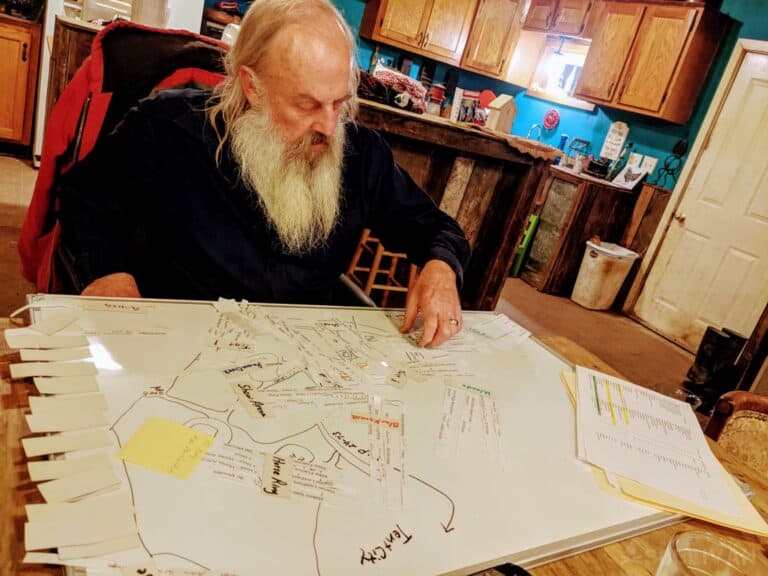This is it. The real thing. Sirens pierce the air. The acrid tang of smoke is on the wind. You aren’t waiting for any more bad news from the talking heads.
You tell your spouse and kids to grab their BOBs as you load your kit into the back of the family SUV. A quick pre-departure checklist and you are off to your cabin on the edge of the forest.

Weaving around clots of people running to and fro on the street, and all too cognizant of the sunlight getting hazier with ever more smoke in the air, you finally get clear of the city before sunset, when, you have little doubt, things will get really bad.
You can smell the fear and tension in the SUV. It has been a quiet, nerve-wracking drive, but as the gravel crunches under your tires and you round the last bend in the trail to your well-stocked cabin you let out a sharp breath of relief…
Only to feel icy pins and needles of disbelief march over your guts as your gaze takes in the smoldering ruin of the cabin.
Detritus and wrappers scatter in the hazy wind like dry leaves. Your spouse stares in numbed disbelief. The kids sob quietly. Your supplies in the SUV will only last a few days, max. What will you do now?
Table of Contents
No Plan Survives Contact
Good question. If you were banking on your primary, and in this instance, only bug-out location and stash of supplies to see you through the crisis, you are going to have a bad time. This simple example scenario sharply illustrates the necessity of having workable, pre-arranged backup plans.
Redundancy is life in any high-risk activity: Skydivers have backup chutes.
Any trans-ocean flight will happen on a plane with two, three or four engines. Cars have spare tires. Any gunslinger worth his salt will carry spare ammunition or a backup gun.
So too must it be for your SHTF planning. Any essential component you are counting on for survival, from equipment to skills to evacuation plans must, must have at least one and preferably two or more backups in place for you to declare it reliable.
This sounds like work, and it is, but probably not as much as you are imagining.
The U.S. military in particular are masters at backup and contingency plans, as well they should be.
Even in peace time training, lives are weighed in the balance of much of their training and other activities, and without a solidly executable plan ready to implement immediately in the case of primary plan failure, people will die. You can imagine what the butcher’s bill would be in an actual warzone.
The adage you will hear repeated constantly among military service personnel and historians of military strategy is “no plan survives first contact with the enemy.” For our purposes the “enemy” is the crisis that has completely upended our lives and perhaps civilization as we know it.
Knowing this, accepting it, is the first step toward formulating durable, flexible plans that will be adaptive no matter what curveballs get thrown your way.
In the remainder of this article, we’ll explore a concept the military devised for maintaining communications in deteriorating conditions that we will borrow to streamline, organize and simplify our backup planning and strategies.
The Importance of Planning
We have all heard the jingles, adages and aphorisms urging the listener to plan well. “If you fail to plan you plan to fail,” “Proper Prior Planning Prevents Predictably Poor Performance,” “A goal without a plan is merely a wish,” and countless others.
As grating as they might be sometimes, those sometimes pithy pieces of wisdom only attained their ubiquitous stature because they are true! If you do not have plans to meet your goals, whatever they may be, you trust the majority share of your fate to luck.
Sure, proponents of swashbuckling improvisation and adaptability may laugh at the idea that any plan will endure in the face of chaos, and rapid adaptation has value all its own.
But the fact remains that without the insights gleaned from planning you will probably at best be left paralyzed by indecision in response to a major stressor, or at worst you will react poorly, choosing a course of action that may have terrible consequences.
Planning is, after all, a form of rehearsal. Rehearsal is a subset of practice and practice is what separates the skilled, the ready, from the unskilled.
When you plan, seriously plan, even if it is just a cursory review and refinement of existing procedures, you are taking your brain on a “dry-run” of the event you are preparing against.
This repetition, drill, whatever you want to call it will yield confidence, and confidence in your abilities, and a sincere belief that you are ready and able to survive whatever comes your way is foundational to a good, positive mindset. A positive mindset is essential to prevailing over any crisis.
Planning at its basest is simply making decisions ahead of time based on the synthesis of all information you have available at the time.
By making those decisions now, you will cut down or eliminate indecision when it is time to act. A plan that breaks down will see you sitting at the intersection of indecision once more, unless you have another plan to fall back on.
Essentially, sound planning will yield speed, momentum and decisiveness in a stressful situation.
Combined with good, on-the-fly problem solving skills and a willingness to adapt you’ll be literally and figuratively miles ahead of those lost souls who are running around like the proverbial headless chickens when things go bad in a big way (or even a small way).
PACE
PACE is an acronym used by the military originally to describe a communication plan.
The letters in pace stand for Primary, Alternate, Contingency and Emergency, and refer to different systems or technological methods of maintaining communications to ensure mission success.
It has been handily repurposed with success for implementation of backup plans in other sectors of the military, and for emergency planning in general.
Each element in a PACE plan is intended to be used in descending order of preference based on prevailing conditions or as a result of being overtaken by events.
“Primary” describes the main element, the one you will be using as standard, and is preferential to the others. It might be the most reliable, or simply offer the most advantages.
“Alternate” describes exactly what it says; an alternate plan that is often just as good, or close to as good, as your Primary plan.
Typically your alternate plan will be implemented or at least monitored alongside your Primary plan as a “backup parachute” that you can deploy immediately in the event of primary failure.
“Contingency” in the PACE plan describes a method that will be implemented if you cannot employ the first two. It is often not as efficient as your first two choices, and may be more laborious or riskier, but is still viable to achieve your objective.
“Emergency” is the element that will only be utilized when all the others fail and will often entail serious delays or risks.
Using this simple acronym as a mnemonic device, you can devise intelligently layered plans to accommodate every essential task that will be required when dealing with a crisis.
The beauty of using PACE as your primary organizational aid for planning is that it scales large or small effortlessly.
You can use PACE to ensure you have multiple solutions for tasks like fire starting and self-defense or for laying out multiple, complex evacuation procedures. PACE can help you plan it all.

Considerations for Planning
A plan can be as complex or simple, as coarse or as detailed as you like.
Generally speaking, people, including you, perform better when given simple, easy to remember plans with only a few guidelines for execution versus door-stopper portfolios of intricate strategy with every conceivable mishap itemized and accounted for.
Speed of implementation also counts; you will not have forever to finalize your Master Plan. A simple, well-rounded and adaptable plan now is better than a flawless, comprehensive one eventually.
Leave room to intangibles and unknowns in your planning. Some things simply cannot be anticipated or effectively planned for ahead of time.
It is fine to plan for the one-in-a-million occurrence, but prioritize your efforts on mitigating the most severe, most likely incidents where you live, then less severe or less likely, and finally very unlikely no matter how severe.
Take the time once you have established your responses to any particular threat to review them mentally and physically, where applicable.
Changing conditions may alter your plans, or unforeseen snags or mishaps may scrap them entirely after a dry run. Practice and experience will sharpen you and refine your procedures.
Examples of PACE at Work
The below examples show what PACE planning looks like on a very basic, intuitive level for both equipage concerns and complex responses. I have added my commentary where appropriate.
Obviously you can chart out every step that constitutes your plan, but I am omitting much for brevity and clarity here, and I am further assuming that when it comes to rudimentary readiness basics like keeping a BOB packed, maintaining your vehicle and performing basic rehearsal with your family that these items will already be in place.
If you have no implemented these fundamentals, you will find much to guide you here on Survival Sullivan and elsewhere on the web.
Equipment, Fire Starting
- Primary: Lighter and pre-made tinder.
- Alternate: Weatherproof matches in storm container.
- Contingency: Fire steel and striker or knife.
- Emergency: Bow-drill or other primitive method.
Notice how the first two elements are basically as effective as each other? See how the Contingency plan is viable, but not quite a sure or as efficient as either the Primary or Alternate plans?
Notice how slow and laborious the Emergency plan is; really good skill to have, but not my first choice if I have any other when I want a fire right now.
Some may balk at this order of operation considering the lighter and matches are both consumables, and perhaps should be saved for dire circumstances. That is arguable, but for my objective, “Start a fire” I want to plan-in speed and efficiency. You may be wet, cold or both, and minutes count when hypothermia is a risk.
Procedures, Fleeing House if Compromised
Leaving Anytown, USA and heading for your cabin in the woods on the outskirts of Corneria, USA.
Primary: Load family and Bug-Out gear into SUV when line-in-sand is crossed. Take Hwy. 1 to Corneria at best speed.
Alternate: If Hwy 1. impassible or unsafe, take Route 30 to Green Cliffs, then reroute to Corneria via Interstate 70 to approach from opposite side of town.
Contingency: If travel by major road is impossible, take smaller county highways and off-road paths directly to cabin in Cornelia. Ensure additional fuel carried to accommodate.
Emergency: If vehicular travel impossible, 3 days of steady hiking will bring us close to cabin. With enough rations trip will not be too arduous as water is plentiful along route.
Again, the Primary and Alternate plans are two sides of the same coin, and you might opt to make your Alternate your go-to prior to departure depending on any last minute intel or reporting you receive.
In this example, the Contingency plan would be workable and certainly viable, but would definitely take longer. A thorough knowledge of the local area and surrounding county would be very beneficial or essential.
The Emergency plan is far less desirable than any of the others, but can be accomplished if you had to. Knowing the route and your family’s capabilities as well as having appropriate equipment for camping to ease the journey will be critical.
Equipment, Self-Defense
- Primary: Shotgun, loaded with No.1 buckshot, slugs and additional buck in reserve.
- Alternate: Handgun, semi-auto pistol, 5 spare magazines.
- Contingency: Pepper spray.
- Emergency: Folding pocket knife.
The name of the game here is decisive effectiveness and standoff capability. The Primary and Alternate means are both firearms, the Contingency solution is still ranged, while also being small and light, and the Emergency element is your weapon of desperation, as bringing a knife to bear entails far more risk to the user than any ranged weapon.
At any rate, using PACE to plan your armed response to threats guarantees you have multiple tools to choose from in the event of loss or breakage. Or you will have something to hand off to a friend or family member.
Start Implementing PACE
Planning is critical to success in any high-stakes venture or event. Having redundant backup plans in case of failure is just as crucial.
Using what you have learned about PACE in this article, you can easily formulate and implement plans to cover any eventualities you might be anticipating. Remember that it is not a matter of if something will go wrong, but a matter of when. Plan accordingly.


Charles Yor is an advocate of low-profile preparation, readiness as a virtue and avoiding trouble before it starts. He has enjoyed a long career in personal security implementation throughout the lower 48 of the United States.

You think of almost everything,but look out for the thing you miss ,like when all else fails. retreat!
***This is it. The real thing. Sirens pierce the air.***
I’m going to take the ‘contrarian’ view again regarding much of this essay. In my opinion, if you’re in a city large enough that you need to evacuate, and you’ve waited until the sirens are screaming, you’re already too late.
http://ecpmlangues.u-strasbg.fr/civilization/geography/maps/US%20Population%20density,%202010.png
Consider the really dense population places. Many of those will require at least a couple of hours to leave even in ordinary peaceful times. Road gridlock means you’ll start down endless miles of streets/sidewalks/alleys on foot, and I can’t see how that’s a bit better than being back at home. I’d not willingly live in such a place, but if I did my “retreat” would be a previously prepared place within that same city.
After all, what are the possible reasons for sudden “civic unrest”. Instant and total loss of utilities – water and electricity – would be one such. If this happened unexpectedly I’m respectfully going to suggest you’re not going anywhere. The roads would jam with stopped/wrecked vehicles very quickly and the blockage would be total. Unless you’re part of a very large group of organized refugees walking out of town, I doubt you’d have any chance unless the operation was supervised by many police and soldiers. And where would the masses of refugees go? Looking again at that map, how many of the surrounding “empty” areas would be willing (or able) to take in 75 thousand extra people. What about a couple million or more people from New York or a quarter million from Miami?
Another reason for an instant panic would be an outbreak of some awful disease. This is a situation I no longer dare to “google”, but I recall from the Bush-The-Dumber years reading of federal disaster plans to quarantine entire cities. Once again, you’ll either survive the epidemic in your big metropolis or you’ll die there. Showing up on the fringes would cause you to get the same treatment many black American citizens received when they were trying to leave New Orleans during Katrina – turn around or die on the spot in a hail of bullets.
Having a retreat place is not something most Americans can even consider. The economic levels of the bottom 90% are moving downward, and the process is accelerating. Nor could most buy 4-wheel drive evacuation vehicles, or even the most basic supplies. They live on the edge, and missing a couple of paychecks already forces them into the ranks of the homeless.
***PACE***
My search for that indicated it is something Special Forces do. My impression of the capabilities of Military Personnel from reading history and recalling the Uniformed People I have personally known is that they’re no more adept at special planning and organization than anybody else. General Douglas MacArthur had made it to the very top of the US Army, yet in the Philippines in 1941-2 he continuously acted like a clueless dweeb.
Still an opinion, but if you’re going to be a refugee you’d darned well better look harmless at such times as you’re spotted at all, and a big shotgun isn’t going to make any good impressions with anyone except for the random bandit/low-life. Those folks might be best avoided by travel at night and in bad weather, and if encountered, then handled by better concealed weapons. Maybe if the shotgun was a disassembled and well hidden short double….
It’s not impossible to have a more-or-less organized evacuation. The USSR moved much of the population and most of the industry out of reach of the invading Nazis during WW2. I’m not a bit sure that the US of A of either Obama or Trump retains such a capability. Too much downsizing of the “damned government” and too much indifference of the Top 1% these days, or so I fear.